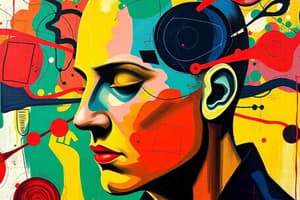Podcast
Questions and Answers
According to the Yerkes-Dodson Law, what happens to performance as arousal continues to increase beyond the optimal level?
According to the Yerkes-Dodson Law, what happens to performance as arousal continues to increase beyond the optimal level?
- Performance improves dramatically.
- Performance is not related to arousal levels.
- Performance declines due to strong anxiety. (correct)
- Performance remains at its peak.
If a student values getting a good grade in a class at 0.80 and believes they have a 0.70 chance of achieving it, according to value x expectation theory, what is their motivation level?
If a student values getting a good grade in a class at 0.80 and believes they have a 0.70 chance of achieving it, according to value x expectation theory, what is their motivation level?
- 0
- 1.50
- 0.56 (correct)
- 0.10
Which of the following is an example of addressing cognitive dissonance?
Which of the following is an example of addressing cognitive dissonance?
- Changing one's behavior to align with one's beliefs. (correct)
- Focusing only on information that confirms existing beliefs.
- Ignoring the discomfort caused by conflicting beliefs and actions.
- Avoiding new information that contradicts existing beliefs.
In Weiner's attribution theory, which component refers to whether the cause of an outcome is due to something within the person or outside of the person?
In Weiner's attribution theory, which component refers to whether the cause of an outcome is due to something within the person or outside of the person?
According to the content, what is a key aspect of 'Backward-Reaching Transfer' in cognitive learning?
According to the content, what is a key aspect of 'Backward-Reaching Transfer' in cognitive learning?
How does 'interleaving practice' relate to desirable difficulties?
How does 'interleaving practice' relate to desirable difficulties?
If a student consistently attributes their failures to a lack of innate ability, which is an unchangeable factor, what kind of mindset is this representative of, according to Carol Dweck?
If a student consistently attributes their failures to a lack of innate ability, which is an unchangeable factor, what kind of mindset is this representative of, according to Carol Dweck?
Which teaching strategy best exemplifies Vygotsky's concept of scaffolding?
Which teaching strategy best exemplifies Vygotsky's concept of scaffolding?
When a person uses previous knowledge to formulate potential solutions, which type of creative approach is being employed?
When a person uses previous knowledge to formulate potential solutions, which type of creative approach is being employed?
What is the defining characteristic of a conjunctive concept?
What is the defining characteristic of a conjunctive concept?
Flashcards
Types of Motives
Types of Motives
Primary motives are for physical needs (e.g., thirst), while secondary motives are learned (e.g., religion). Stimulation motives heighten experiences.
Value and Expectation
Value and Expectation
Motivation = Value x Expectation. If either is zero, there's no motivation.
Social Learning Theory
Social Learning Theory
Learning through imitation by observing a model, it impacts motivation.
Cognitive Dissonance
Cognitive Dissonance
Signup and view all the flashcards
Weiner's Attribution Dimensions
Weiner's Attribution Dimensions
Signup and view all the flashcards
Helpless Goal Orientation
Helpless Goal Orientation
Signup and view all the flashcards
Performance-Avoidance Goal Orientation
Performance-Avoidance Goal Orientation
Signup and view all the flashcards
Work-Avoidance Goal Orientation
Work-Avoidance Goal Orientation
Signup and view all the flashcards
Entity vs. Incremental Ability
Entity vs. Incremental Ability
Signup and view all the flashcards
Near Transfer
Near Transfer
Signup and view all the flashcards
Study Notes
Arousal Theories
- Primary motives are physical needs like thirst, exhaustion, hunger, heat, and cold.
- Secondary motives are learned through experience, for example, motivation for religion, brushing hair, or using a cell phone.
- Stimulation involves heightening experiences and going beyond basic needs and incentives.
- Optimal performance occurs when arousal and motivation reach a certain point and then decline.
- The optimal arousal level for performance varies individually.
- Too much stress and arousal can lead to procrastination.
- Optimal stress and arousal varies by the type of arousal and task.
Value and Expectation
- Motivation results from the amount of value multiplied by expectation.
- Value refers to the importance or worth of a task.
- Expectation refers to one's expectation for success and perceived odds of success.
- The equation is Value x Expectation = Motivation, resulting in a possibility between 0 and 1.
- If any factor (value or expectation) is 0, then there is no motivation to do the task.
- Intrinsic factors, like disliking a task, can hinder value.
- Extrinsic factors, like too much stress, can hinder value.
- Negative feedback can hinder expectations.
- Increasing value involves finding intrinsic motivation and identifying skill development.
- Increasing expectations involves breaking a task down into smaller parts.
Bandura's Social Learning Theory
- Learning occurs through imitation after observing a model.
- Self-efficacy, one's belief in their ability to complete a task, relates to motivation.
- Self-efficacy is determined by vicarious experiences (watching others) and feedback from others.
Cognitive Dissonance
- Cognitive dissonance occurs when what we know or believe does not match what we are experiencing or learning.
- Motivation is linked to reducing cognitive dissonance to better understand discrepancies.
- Cognitive dissonance can be reduced by changing beliefs, changing behavior, or compromising on beliefs and behaviors.
- A defense mechanism against cognitive dissonance is denying its existence, also known as isolation.
Weiner's Locus of Control or Attributions
- Task completion relies on past experiences.
- Successes and failures are attributed to various factors.
- Motivation is affected by past successes and failures.
- Motivation is impacted by whether we were successful in the past and why.
- Motivation remains even after failures.
- The locus (internal or external), stability, and control are three independent components that affect motivation.
- Locus refers to the location or source of the attribution, being internal (something you possess) or external (something the environment or someone else provided).
- Stability refers to whether the factors leading to an attribution will be present again.
- Control relates to whether practice is a controllable attribution.
Examples of Locus of Control or Attributions
- Seth attributes his test success to unstable, uncontrollable luck (external locus).
- Steve attributes his test failure to his lack of intelligence, an internal, stable, and uncontrollable factor.
- Sally attributes her poor test performance to not studying, which is internal, unstable, and controllable.
- Sandra attributes her success to the teacher liking her, which is an external, controllable, and stable factor.
Attributions
- Accurate attributions may not always be the most motivating.
- Balancing honesty with motivational attributions is important.
- Encouragement can be motivating.
- Motivation is easier after success and harder after failure.
Trait Theory
- Trait theory looks at general motivational trends over time.
- Achievement and affiliation are considered significant motivators.
- n(Ach) represents the need for achievement, which drives people to work towards personal goals.
- n(Aff) represents the need for affiliation, and to know how much time was spent because of a need for affiliation.
- n(Ach) + n(Aff) = 100 and are the most commonly used.
- The "healthiest" motivator depends on personal goals, emphasizing achievement or affiliation.
- Knowing an individual's general trends in affiliation and need helps motivate them toward their goals.
Types of Goal Orientation
| Type of Goal | Example |
|---|---|
| Helpless goal orientation | Focusing on how little time they have to complete the paper |
| Performance-avoidance | Avoiding speaking for a group so they won't look "dumb" |
| Work-avoidance goal | Completing an assignment with as little effort as possible |
| Social goal | Wanting the teacher to view them as responsible |
| Performance-approach | Producing the best essay in the class |
| Mastery goal | Understanding the difference between well-written and poorly written essays |
- Helpless goal orientation involves barriers preventing task completion.
- Performance-avoidance goal orientation aims to avoid appearing foolish.
- Work-avoidance goal orientation focuses on doing the minimum to finish.
- Social goal orientation is motivated by affiliation or impressing someone.
- Performance-approach goal orientation is motivated by wanting to be the best.
- Mastery goal orientation is motivated by self-improvement.
Entity vs. Incremental Ability/Intelligence
- Carol Dweck's (2000) book is titled Mindset: The New Psychology of Success.
- Ability/intelligence can be viewed as a fixed entity or a changeable increment.
- Viewing intelligence as a changeable increment increases expectations, desires, and motivation to try or practice.
- A fixed mindset inhibits motivation for improvement.
- Performance goals are related to a fixed mindset, while mastery goals are related to a changeable mindset.
- Fixed and changeable mindsets relate to views of being "good" or "bad."
Incremental Views
- Praising, encouragement, recognition, and effort increases incremental views.
- Redefining failure as a learning opportunity can increase incremental views.
Optimal Experiences and Flow
- Flow is related to the perceived challenge of the task and the perception of one's skill level.
- It is important to be neither apathetic nor uncaring.
- The challenges in promoting flow involves your perception of skill level and the challenge of the task
- Breaking down goals and practicing mindfulness can promote work flow.
Self Regulation
- Goal setting, monitoring goals, self-reflection, self-evaluation, and strategy use are components of self regulation.
- Strengthening weaknesses, recognizing strengths, and using mnemonics or rewards systems are forms of strategy use.
Climate Variables
- Order and safety, emphasis on success, and appropriate level of challenge promotes better climate variables.
- Expectations should be generally understood, processes consistent, and safety to explore boundaries maintained.
- This ensures people maintain some flow state.
Task Comprehension
- Understanding the task is the focus.
- An understanding of what you're supposed to be doing is motivating.
How Teachers Can Increase Motivation
- The personal efficacy of the teacher allows students to do well and offer them unique challenges.
- Self evaluation improves skills.
- Teachers can model self-regulation by talking about goals and areas of improvement.
- Enthusiasm for learning should be presented by the teacher but they should remain caring.
- Expectations should be maintained since next time will be better
Instructional Variables
- Focus and organization.
- Personalization/relevance to what they are learning.
- Involvement - having learners involved in the learning, interactive, activities, group discussion.
- Constructive feedback.
The Power of Yet
- Kids who persisted when they faced challenges used the language "I don't get it yet."
- Kids who were giving up would say "I don't get it."
Specific Motivation Issues
- Low achievement with low expectations can be addressed by asking why they don't have high expectations.
- High anxiety can be addressed by breaking down information and using anxiety-reducing techniques.
- Threatened self-worth can be addressed by pointing out the benefits of what they would gain.
- Don't let them base their self worth off of a failure because they can learn from it.
- Procrastinators can be helped by encouraging time management techniques and breaking up the tasks.
- Perfectionists can feel anxiety related to procrastination because of the failure to meet an impossible standard.
Hard to Reach Low Achievement
- When students identify with the difficulty that is holding them back they can begin addressing it.
- Break down goals into small but still challenging goals so that they feel they accomplished something.
Bruner's Conceptual Understanding
- Concepts are our ideas or understandings of our experiences.
- Concept formation happens instantly and can take years to perfect as we define and provide clear examples.
- Concept maps offer a visual representation of a concept's hierarchical organization.
- Prototype matching compares the item with similar items in a category
- Hypotheses are developed about concepts.
Cognitive Approaches to Learning: Types of Transfer
- Transfer refers to applying something learned to another situation.
- Near transfer doesn't require much thought (ex: driving two small cars).
- Far transfer requires more thought about applying what was learned (ex: driving a truck after driving a car).
- Low road transfer are skills transferred automatically without thinking.
- High road transfer requires reflection and experience.
- Forward-reaching transfer involves thinking about how to use information in the future.
- Backward-reaching transfer involves connecting new information to something from the past through learning.
- Sometimes transfer is not possible given no connection to the past or a lack of use-case.
Factors That Affect Transfer
- Contextual similarities: the more similarities between the situation and learning, the easier the transfer.
- The use of examples is more effective learning than simply using definitions.
- Depth of learning actively engages students and enables deeper learning.
- Addressing errors and misconceptions as you learn new things mitigates wrong approaches later on
- Timely feedback is helpful.
- Teaching, learning, and memory strategies facilitate transfer by having students apply teaching strategies.
Desirable Difficulties
- Massed practice, predictable processes with constant cues, blocked practice, immediate feedback, re-studying, correct answers, and inaccurate metacognitive monitoring are improvements over a long term learning.
- Spaced practice, variation in learning conditions, interleaved practice, delayed feedback, retrieval practice, and generation foster long-term learning.
- While the immediate feedback of performance techniques is beneficial, they are hard to maintain.
- Performance techniques are helpful for gaining motivation, however, long-term learning is affected.
- Failures and frustrations negatively affect the student's motivation which is why some reviewers think they are repetitive and wasteful.
Issues in Decision Making
- Confirmation bias confirm what we already believe.
- Belief perseverance is what happens when we refuse to rethink our beliefs.
- Overconfidence bias: You are so confident, you don't bother checking.
- Hindsight bias: After a decision, the realization that your decision wasn't the best.
Heuristics in Decision Making
- Heuristics are shortcuts or rules of thumb.
- Availability heuristic: Salience leads us to believe instances are more common than they are.
- Representativeness heuristic: relying on similarities to known situations in uncertain situations lessens true possibilities.
Problem Solving
- Problem solving often precedes decision making.
- These often occur together and are determined by the ability to find and frame problems.
- We can develop great strategies by using certain components.
- *Subgoaling: Breaking up a big problem in to smaller pieces
- *Algorithms: very defined segments, like math problems or recipies
- *Means-ends analysis: (backwards strategy) how much money do I need, how many shifts do I need to work to pay for the car?
Approaches to Problem Solving, Successively
- Trial and Error: If you identify a solution, you try one and if it doesn't work, you try another.
- Focus Gambling: Identify a solution, usually due to lack of resrouces, you try one solution and if it doesn't work, you stop.
- Conservative Focus: What we tend to use if we have some experience, we organize by lielihood and we reevaluate if it doesn't work
- Simultaneous scanning: resources are used and we can do them all at once.
Obstacles to Problem Solving
- Fixation: Being so focused on one thing causes you to fail to see what's there
- Lack of motivation: Can't get started
- Lack of persistence: Can't continue
- Inadequate emotional control: Emotions get in the way.
Creative Thinking
- Creative thinking uses unique approaches.
- Convergent thinking encourages learners to take opinions and variety of backgrounds to a common understanding.
- Divergent thinking enables more freedom.
- Both can promote creative thought but divergent thinking is more commonly creative.
- Domain-relevant skills involve having a background.
- Encourage creativity.
- Intrinsic task motivation: It is more likely to be creative when we enjoy something.
Critical Thinking
- It is the analysis and evaluating information.
- Work with learners and present criticisms and opposing viewpoints to encourage critical thinking.
Constructivism
- Constructivism says learners should create their own knowledge and that past experiences, culture, and language construct our knowledge.
Assumptions
- Expertise exists and that the responsibilty of learning in on the learner.
- We can grow from the foundation.
Two Basic Types of Constructivism
- Cognitive constructivism includes a view of children as "little scientists."
- Schemas organize information or concepts.
- Equilibration balances cognition.
- Assimilation is when new information fits into existing schemas.
- Accommodation changes the basic schema
Types of Concepts
- These are classifications for some concepts, not all fit all these, these may be combinations.
- Conjunctive concepts use multiple reasons for belonging.
- Disjunctive means there are multiple requirements that are considered as the concept.
- Relational: Concepts relate to some standard.
Promoting Concept Formation
- When the rules and examples are used right, students learn what concepts are and are not.
- Providing clear examples that relate to existing maps helps students better understand.
- Generate Hypothesis or Predictions about where concepts may be useful.
- Check for student understanding and generalization.
Vygotsky's Social Cognition
- Learning occurs through working with others.
- Understanding and learning in social negotiation relies on others.
Approaches of Social Constructivism
- Scaffolding slowly removes supports as students learn
- Service learning is the construct of our learning.
- Problem-based learning applies real-life situations to new learning.
- Cooperative learning relies on small group collaborations.
Studying That Suits You
Use AI to generate personalized quizzes and flashcards to suit your learning preferences.





